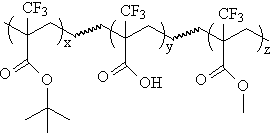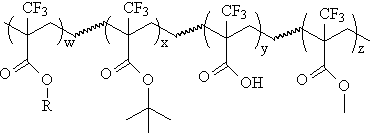|
|
||
|
Development of 157 Photoresist Materials The purpose of this document is to provide timely public access to the 157 nm resist development work being done in our laboratories under contract from International SEMATECH.It is our goal and SEMATECH's goal to disseminate this information as rapidly and widely as possible in hope that doing so will accelerate the availability of 157 nm resist materials to the members of International SEMATECH.
Acrylate polymers have been used extensively in 193 nm photoresist designs due to their facile functionalization and favorable polymerization characteristics(1). Unfortunately, the p-system in these polymers contributes a large amount of absorbance at 157 nm and effectively precludes their use at this wavelength. However, our research group has recently shown the absorbance of these materials can also be significantly decreased through the addition of electron-withdrawing substituents(2). For example, poly(methyl trifluoromethacrylate) was prepared from the commercially available acid(3), and polymerized according to literature procedures(4).
The absorbance spectrum of the final homopolymer is displayed below, showing that this material has an absorbance of ~3 / mm, less than half that of PMMA.
To confirm that the favorable imaging characteristics of acrylates has not been adversely affected, poly(tert-butyl trifluoromethacrylate) was prepared(5) and is undergoing preliminary imaging experiments.
Although the results from these experiments will give some indication of the potential performance available from this class of materials, a candidate for an actual photoresist polymer will most likely have to follow a model similar to that described for acrylates as 193 nm photoresists(1). To that end, we are in the process of preparing the acrylate ter- and tetrapolymers shown below to determine their imaging potential.
R=Fluorinated alicyclic unit for etch-resistance (see etch resistance section)
References: 2nd Annual Symposium on 157 nm Lithography: UT Poster on Acrylates
Original page created 01/30/01
| |
|
|
||






